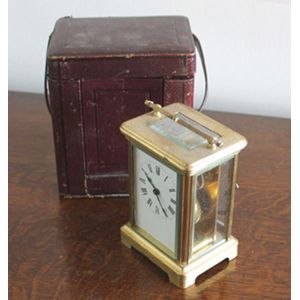Louis XVI Mahogany Corner Cabinet with Marquetry
Louis XVI style mahogany and marquetry corner cabinet, the shaped marble top above a pair of doors enclosing shelves, height 81 cm, width 70 cm, depth 51 cm. provenance: Christopher Davis gallery, Paddington, c. 2003. The Collection of Alan James and Jenny Fletcher, Sydney
You must be a subscriber, and be logged in to view price and dealer details.
Subscribe Now to view actual auction price for this item
When you subscribe, you have the option of setting the currency in which to display prices to $Au, $US, $NZ or Stg.
This item has been sold, and the description, image and price are for reference purposes only.
- Marquetry - In marquetry inlay, contrasting woods, and other materials such as ivory, shell and metal are inlaid either as panels or in a single continuous sheet over the surface of the piece. The design may be straightforward, such as a shell pattern or a basket of flowers, or it may be infinitely complex, with swirling tendrils of leaves, flowers and foliage, such as one finds, for example, in the "seaweed" patterns on longcase clocks of the William and Mary and Queen Anne periods.
- Gallery - On furniture, a gallery is a small upright section, frequently pierced and decorated, around the tops of small items of furniture, such as davenports, side tables, and so forth. Galleries are made in brass or bronze,and be fretted, pierced or solid timber. A three-quarter gallery is one that surrounds three of the four sides of a table, desk or other top.
- Provenance - A term used to describe the provable history of an antique or work of art, and thus an additional aid to verifying its authenticity. Provenance can have an inflating effect on the price of an item, particularly if the provenance relates to the early settlement of Australia, a famous person, or royalty. Less significant are previous sales of the item through an auction house or dealer.
- Mahogany - Mahogany is a dense, close grained red-coloured timber from the West Indies and Central America. It was first imported into Europe in the the early 18th century and its use continued through the 19th century. It was popular for furniture making because of its strength, the wide boards available, the distinctive grain on some boards, termed flame mahogany and the rich warm colour of the timber when it was polished.. The "flame" was produced where a limb grew out from the trunk of the tree, and this timber was usually sliced into veneers for feature panels on doors, backs and cornices.
Some terms used to describe mahogany relate to the country from which it originally came, such as "Cuban" mahogany, "Honduras" mahogany etc. However unless the wood has been tested the names assigned are more a selling feature, rather than a true indication of the timber's origin.
This item has been included into following indexes:
Visually similar items

George V sterling silver three piece teaset oval faceted from on 4 scroll legs with hoof feet, Birmingham, 1924
Sold by
in
for
You can display prices in $Au, $US, $NZ or Stg.

French carriage clock with Roman numerals and carry case.
Sold by
in
for
You can display prices in $Au, $US, $NZ or Stg.

A Chinese red lacquer low cabinet. 67 cm high, 72 cm wide, 45 cm deep
Sold by
in
for
You can display prices in $Au, $US, $NZ or Stg.

Sold by
in
for
You can display prices in $Au, $US, $NZ or Stg.
